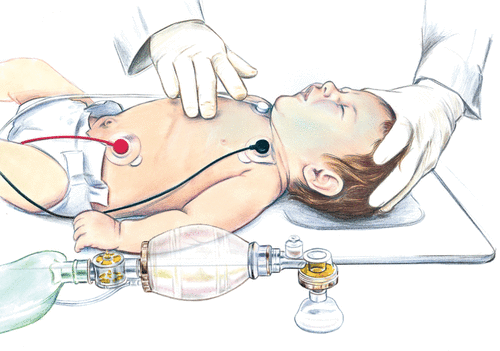Tachycardia in children is a disease where the heart beats faster than normal. It can be a scary condition for parents and doctors. How tachycardia is treated in kids can be very different from how the adults are treated. Health professionals need to gain experience in treating children to be able to deal with pediatric tachycardia effectively. ACLS protocols can be adapted for young patients with tachycardia. ACLS courses are easily available online and are a great addition to any health professional’s career. Read on to know more about pediatric tachycardia, ACLS courses, and the online ACLS renewal process.
What is Pediatric Tachycardia?
When a person’s heart beats way faster than normal, it is called tachycardia. In kids, normal heart rates change as they grow. Here’s a simple guide:
- Newborns to 3 months: 85-205 beats/ minute
- 3 months till 2 years: 100-190 beats/ minute
- 2 to 10 years: 60-140 beats/ minute
- Over 10 years: 60-100 beats/ minute
What Are The Types of Pediatric Tachycardia?
There are two main types of tachycardia in kids:
- Supraventricular Tachycardia (SVT): This starts above the ventricles. The ventricles are the name for the lower chamber of the heart. SVT is the most common type in children. It often starts suddenly and stops suddenly.
- Ventricular Tachycardia (VT): This starts in the ventricles. It’s less common but more serious. VT can be life-threatening if not treated quickly.
Knowing the type helps doctors choose the right treatment. Each type needs different care.
What Are The Signs and Symptoms?
It is important to check the signs and symptoms of tachycardia as soon as possible. Tachycardia in kids can show up in many ways:
- Fast heartbeat
- Chest pain
- Shortness of breath
- Dizziness
- Fainting
- Pale or bluish skin
- Sweating
Babies might feed poorly or breathe fast. Older kids may be able to complain of a racing heart. Some kids may not show any signs. That’s why regular check-ups are important.
How are ACLS Protocols Adapted For Kids?
ACLS stands for Advanced Cardiovascular Life Support. It has rules for treating heart problems. But these rules need changes for kids. Here’s how:
- Assessment:
- Check the child’s age and weight
- Look for signs of poor blood flow
- Check if the child is awake and alert
- Airway and Breathing:
- Make sure the airway is clear
- Give oxygen if needed
- Watch how the child breathes
- Circulation:
- Feel for pulses
- Check blood pressure
- Look at skin color
- Identify the Rhythm:
- Use an ECG to see the heart rhythm
- Decide if it’s SVT or VT
- Treatment:
For SVT:
- Try vagal maneuvers first (like putting ice on the face)
- If that doesn’t work, give adenosine
- In some cases, use cardioversion (a small electric shock)
For VT:
- If the child is stable, give medicine
- If unstable, use cardioversion right away
- Reassess:
- Keep checking the child
- See if the treatment worked
- Change the plan if needed
What Are The Special Considerations for Kids?
Treating tachycardia in kids needs extra care:
- Use weight-based doses for medicine: Kids need smaller doses than adults. The dose depends on how much they weigh.
- Have child-sized equipment ready: Adult-sized tools can hurt kids. Special small tools are needed.
- Involve parents to keep the child calm: A parent’s voice can help a scared child. This can make treatment easier.
- Be ready for fast changes in the child’s condition: Kids can get better or worse quickly. Doctors need to watch closely.
- Know when to call for more help: Sometimes, a child needs special heart doctors. Anyone who deals with children with heart conditions must know when to call for advanced medical help.
How To Enroll in ACLS Certification and Recertification?
To treat pediatric tachycardia, you need special training and ACLS certification helps. Here’s what to know:
- ACLS courses teach how to handle heart emergencies
- Pediatric Advanced Life Support (PALS) focuses on kids
- You need to recertify every two years
- Recertification keeps your skills up-to-date
- It teaches new methods and rules
To get certified:
- Take a course: Learn about heart problems and how to treat them.
- Pass a written test: Show that you understand what you learned.
- Show your skills in practice: Prove you can use your knowledge in real situations.
To recertify:
- Take a shorter refresher course: Update your knowledge.
- Pass another test: Show you still know the important things.
- Show your skills again: Prove you can still use your skills well.
Keeping your certification current is very important. It helps you give the best care to kids with tachycardia. Medical knowledge changes fast. Recertification helps you keep up with new ideas.
Conclusion
Pediatric tachycardia is a serious condition. It needs quick and careful treatment. ACLS courses and recertification can help you as efficiently and quickly in treating children with tachycardia. ACLS certification and online ACLS renewal process is simple and easy to follow. With the right knowledge and skills, you can help kids with tachycardia.
Keep an eye for more news & updates on TimesAnalysis.com



